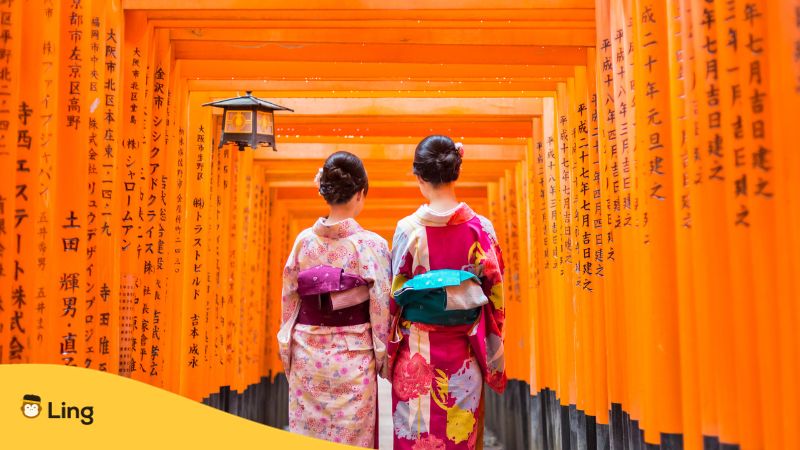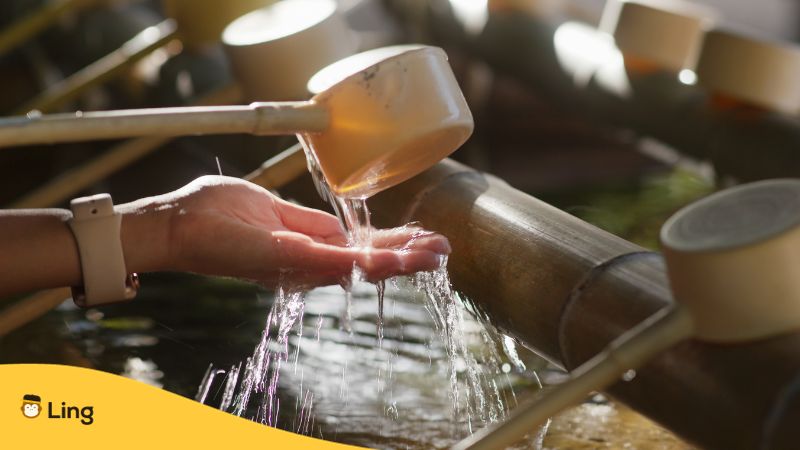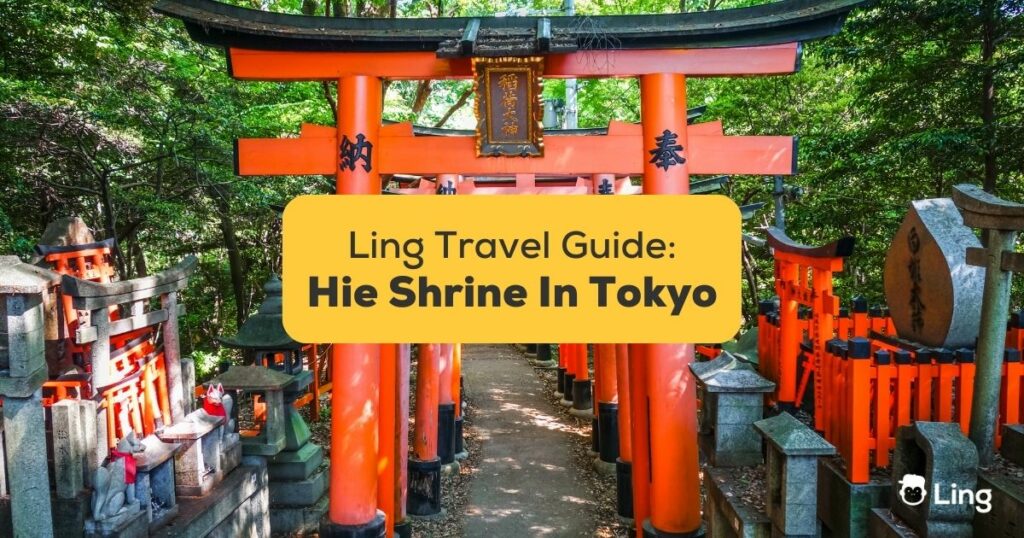Going to Japan but dreading that language barrier? I get it – ordering sushi is one thing, but properly bowing and making small talk at an iconic site like the Hie Shrine without embarrassing yourself? A stress-inducing prospect, for sure!
Lucky for you, I’ve got the insider playbook for an immersive cultural experience at the Hie Shrine that will have your Japanese skills soaring smoothly in no time. Make a quick pitstop at this hidden gem right in bustling Tokyo. Trust me that you’ll walk out with way more confidence in Japanese customs AND vocabulary after I lead you through etiquette, prayers, and even eavesdropping on locals spilling their wishes.
Forget stale workbooks – by the end of this guide, you’ll be more pumped to practice your new knowledge over post-shrine sake than anything! Let’s begin!
Table Of Contents
Hie Shrine In Tokyo
Nestled among skyscrapers and government buildings lies one of Tokyo’s hidden gems – the historic Hie Shrine. You’d never know that this serene place has been around since the 15th century! Believe it or not, it was built way back in 1478 to honor Ōta Dōkan, the samurai who constructed the original Edo Castle. Talk about old school!
Today, the Hie Shrine stands as a beautiful reminder of traditional Japanese architecture amidst the concrete jungle. From the graceful sloped roofs to the majestic pine trees, this spot oozes harmonious design. It’s considered one of Tokyo’s most important shrines, too, especially with its badass tunnel of 90 vibrant red torii gates!
But there’s natural beauty here too. Make sure to visit in spring, when the ancient cherry blossom tree near the entrance erupts into cotton candy pink. Its flowers are truly stunning. And if you think sakura season is grand at Hie, just wait until you see the wisteria blooming in the courtyard!
I have to admit, I giggled at the shrine’s attempt to merge past with present. Notice their high-tech escalators ingeniously flanking the traditional stone staircase? Something tells me the spirits here have embraced modern life just as much as history.

Key Features Of The Hie Shrine
The Tunnel Of Torii Gates
Let’s start with the star of the show – the vermillion shrine gates that make for the perfect Instagram backdrop. Beyond the main hall lies a 200-meter path flanked by around 90 torii gates. Painted vibrant red and densely packed together, they’re quite the sight! This iconic tunnel leads into the sacred Tomioka Hachimangu shrine.
Sanno Matsuri Festival
Each June, the Hie Shrine puts on the spectacular Sanno Matsuri festival, drawing over one million viewers across three days! Consisting of regal processions and Hie’s mikoshi (portable shrines), it honors the deified shogun Tokugawa Ieyasu. We’re talking elaborate 16th-century costumes, solemn rituals, and sublime ancient music.
Monkey Messengers
Unlike most shrines guarded by lion-like komainu or dog statues, the Hie Shrine has monkeys standing watch! These capuchin guardians are called masaru, and are considered divine messengers of the enshrined deity Oyamakui no Kami. At the entrance to the main hall, you’ll see stone and bronze monkey couples that worshippers pray before, asking the simian statues to bless them and convey prayers. So if you need a little extra good fortune on your side, be sure to seek out the charming monkey messengers!
Precious Treasures
The Hie Shrine also safeguards some of Japan’s most prized historical relics. This includes the renowned Itomaki-no-Tachi, a long sword with intricate lacing on its handle forged by legendary swordsmith Ichimonji Norimune. There is also a sword made by equally skilled craftsman Bizen Osafune Nagamitsu, which once belonged to Emperor Meiji himself!
Visitors can view these national treasures and other artifacts at the shrine’s Treasure House. And in my own experience, I can say that getting to admire such prized Japanese masterworks with your own eyes is a rare treat!
How To Get To Hie Shrine
Ready to make the pilgrimage to this Tokyo hidden gem? The shrine is located at 2 Chome-10-5 Nagatacho, Chiyoda, Tokyo (日枝 神社 in Japanese).
Conveniently, Hie Shrine has three different train stations located within short walking distance:
- Tameikesannō Station – Just 159 meters away! Take the Ginza Line (G6) or Namboku Line (N6)
- Akasaka-mitsuke Station – 368 meters away. Access it via the Ginza Line (G5) or Marunouchi Line (M13).
- Nagatacho Station – 395 meters away. Get there on the Hanzomon Line (Z4), Namboku Line (N7), or Yurakucho Line (Y16).
So no matter where you’re traveling from, Hie Shrine can easily be accessed through Tokyo’s vast transit network. Simply hop off at any of the nearby stations, take a short walk, and immerse yourself in this historic hidden oasis!
Opening Hours Of The Hie Shrine
So, you wanna come see the majestic Hie Shrine here in Tokyo? Well, listen up then for the key info before heading over! This place actually opens crazy early – we’re talking 6 AM daily. Yep, the gates welcome visitors to roam around from the crack of dawn until 5 PM rolls around. That’s plenty of time to explore the rows of vermillion torii gates, admire the old architecture, and say hey to the awesome monkey statues guarding the main hall.
Oh, and make sure to pass through anytime between 8 AM to 4 PM if you need to grab some omamori amulets, charms, or ema prayer plaques. The shrine sells all sorts of little blessings and fortunes to take home during these hours!
Entrance Fee To The Hie Shrine
Now for the real kicker – it’s 100% free to enter Hie Shrine! You can soak up the sights, pray to your heart’s content at altars, or just find your inner peace chilling under the trees without paying a single yen. But if you feel like tossing some change into an offertory box or picking up a cute souvenir, that definitely helps fund this sacred place.
The priests here rely on generous worshippers to keep centuries-old buildings looking pristine. And you’ll wanna help them keep Hie a gorgeous, welcoming oasis for the community, too, right? Plus, supporting them earns you bonus karma points! So come ready to show some appreciation if ya can.

Useful Japanese Words When Visiting The Hie Shrine
Visiting a Shinto shrine like Hie provides a wonderful opportunity to experience traditional Japanese culture and customs. Here are some common words and phrases to listen for during your visit.
Temizuya (手水舎)
The temizuya is the fountain near the shrine entrance that visitors use for misogi – a cleansing ritual before prayer. Purifying your hands and mouth with the water is considered polite and symbolic before approaching the kami spirits.
Torii (鳥居)
The striking vermillion torii gates mark the transition from the mundane to sacred ground at shrines. They signify entry into areas where the kami reside. The arrangement of multiple torii in tunnels, like at Hie Shrine, is especially auspicious.
Kamidana (神棚)
Kamidana are miniature shrines installed in homes/businesses to house kami for personal altars. Hie Shrine features many kamidana around the grounds, where visitors can leave small offerings and prayers.
Ema (絵馬)
These wooden plaques bear messages or wishes to the enshrined kami. Visitors buy ema, then write their hope before hanging the tablet at the shrine to make it come true!
Omamori (お守り)
Omamori are protective amulets sold at shrines to grant luck, health, prosperity, travel safety, and more depending on which one you get. They make for great traditional souvenirs too.
Kami (神)
Kami is the term used to describe the sacred spirits and deities worshipped in Shinto. At Hie Shrine, the main kami honored is Ōta Dōkan, along with eight other local deities.
Shinzen/Haiden (神前・拝殿)
The most sacred area containing the main altar is called the shinzen, while the haiden is the oratory hall where visitors come to pray before the shinzen. Here you can make offerings and connect with the enshrined kami.
Ready To Step Back In Time?
Stepping into the serene grounds of Hie Shrine truly feels like entering another era. Yet just beyond the vermillion gates lies the thriving metropolis of Tokyo in all its bustling modern glory. This contrast beautifully encapsulates the ability of historic shrines to transport us spiritually, even as we remain firmly planted in today’s world.
Hopefully, learning about Hie Jinja has inspired you to discover more dazzling dimensions of Japan! To pick up more essential Japanese vocabulary and phrases for future adventures, be sure to download the innovative Ling app. Ling offers bite-sized lessons and gamified quizzes tailored to every level that makes language learning fun, fast, and simple.
So go forth and explore Tokyo’s treasures, both old and new – with Ling as your guide!



































































